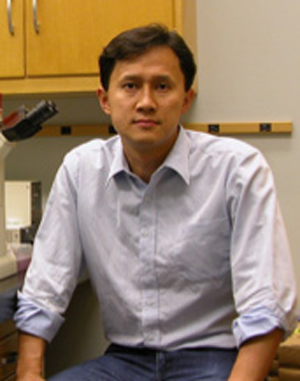Seung-Wuk Lee Turns Viruses into Lenses, Scaffolds
By wchung | 29 Dec, 2025
A UC Berkeley team led by Seung-Wuk Lee has developed a technique to induce viruses to arrange themselves into structured films that can be used as optical devices or cellular scaffolding to grow teeth, bone and soft tissues.
“We want to mimic nature and create many different types of functional structures with a very simple building block,” said Lee, a Cal bioengineering professor of his simple, one-step process for getting viruses to arrange themselves into highly ordered patterns to create films of various useful properties.
Lee’s work both simplifies and extends the degree of control that can be exerted over viral self-assembly to create large-scale structures by making adjustments at the genetic level.
Lee’s group focused its techniques on a rod-shaped bacterial virus called M13. The technique involves dipping a flat glass sheet into a saline solution containing the viruses. As the glass sheet is pulled out at a slow, precisely-controlled speed, the viruses spontaneously arrange themselves into regular patterns on the glass as the solvent evaporates.
By varying the viral concentration of the solution and the speed at which the glass is pulled out, the technique can create a wide variety of films bearing structures that can be used for different purposes.
One structure features stripes made up of viruses aligned and twisted into a corkscrew shape. A more complex film forms viruses into a structure resembling the arrangement of noodles in a dry ramen packet which can bends light in predictable ways. Different colors can be achieved by changing the pulling speed to vary the spacing and width of the viruses.
Films and crystals that refract light in various ways could be used as filters for displays and a wide variety of photographic processes.
Lee has also used the technique to create cellular scaffolds on which to grow organic tissues. By making some genetic adjustments Lee’s team was able get the viruses to express certain proteins on its surface. Those proteins induced alignments of cells cultivated on top of the films. The films could also be dipped in solutions of calcium and phosphate ions to form sheets of hard material resembling tooth enamel.
Lee began focusing on using genetically engineered viruses to devise novel methods of self-assembling various semiconductor nanoparticles in 2002 while working on his PhD at the University of Texas at Austin. He succeeded in engineering viruses to recognize specific semiconductor material surfaces and organize into periodically ordered structures that could be useful as materials for new opto-electronic devices.
At UC Berkeley Lee has been working on understanding the evolution of bone associated proteins. Recently his team isolated a series of functional peptides to recognize different surfaces of hydroxyapatite crystals (inorganic component of bone) through a bench-top evolution processes called phage display. Surprisingly, the specific binding peptides against hydroxyapatite match with collagen and many other bone associated proteins.
Lee’s group is also developing a general concept called virotronics, which exploit the unique properties of genetically-engineered viruses to carry information to build functional medical and electronic materials and devices.
Seung-wook Lee graduated from Korea University with a BS in chemistry in 1995. He obtained his MS there in 1997. He obtained a PhD in chemistry and biochemistry from the University of Texas in 2003. He served a postdoctoral fellowship at the Lawrence Berkeley National Lab from 2004 to 2005. He won the National Science Foundation’s Early Career Development Award in 2008, the Hellman Family Faculty Award in 2008, the Presidential Chair Fellowship in 2009 and the Berkeley Faculty Research Award in 2010.

UC Berkeley professor Lee Seung-wook has developed techniques for inducing viruses to arrange themselves into useful patterns.
Articles
Asian American Success Stories
- The 130 Most Inspiring Asian Americans of All Time
- 12 Most Brilliant Asian Americans
- Greatest Asian American War Heroes
- Asian American Digital Pioneers
- New Asian American Imagemakers
- Asian American Innovators
- The 20 Most Inspiring Asian Sports Stars
- 5 Most Daring Asian Americans
- Surprising Superstars
- TV’s Hottest Asians
- 100 Greatest Asian American Entrepreneurs
- Asian American Wonder Women
- Greatest Asian American Rags-to-Riches Stories
- Notable Asian American Professionals

